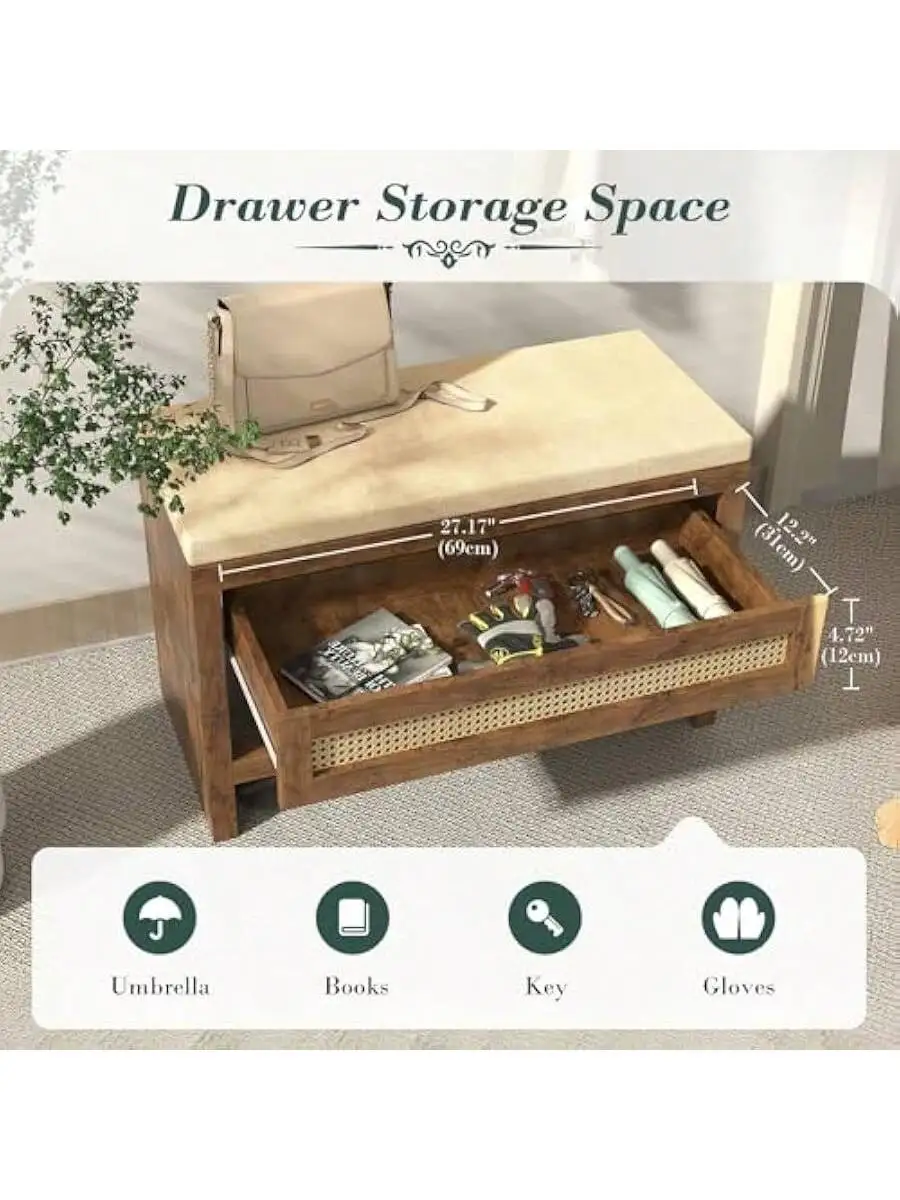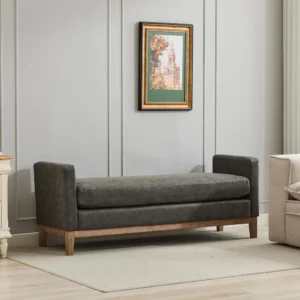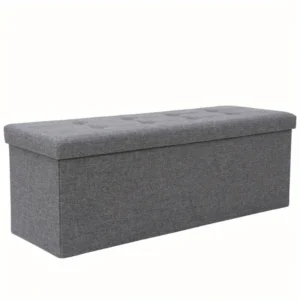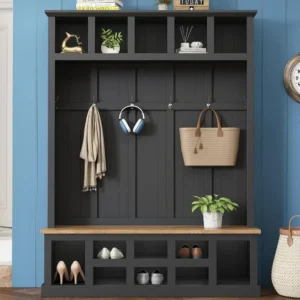Understanding the Entryway Challenge: Why Storage and Seating Matter
The entryway of your home serves as both a first impression and a functional transition space. Yet for many homeowners, this crucial area becomes a cluttered catch-all rather than an organized welcome zone. What separates a functional entryway from a dysfunctional one often comes down to thoughtful organization and practical furnishings.
Most entryways face common challenges that impact daily life:
- Clutter accumulation: Keys, mail, bags, and shoes pile up without designated homes
- Organizational bottlenecks: Morning rushes become stressful when essentials are missing
- Seating scarcity: No place to sit while putting on or removing shoes
- Seasonal overflow: Winter coats and boots or summer beach gear overwhelm limited space
- Wasted potential: Valuable square footage that could work harder with the right solutions
The average person spends nearly 10 minutes each day searching for misplaced items like keys and shoes—that’s over 60 hours annually! An organized entryway significantly reduces this wasted time while creating a more welcoming atmosphere for both residents and guests.
The concept of multi-functionality in furniture design is particularly valuable for entryways because these spaces must work extraordinarily hard despite often limited square footage. When seating combines with storage, you gain dual benefits: a comfortable spot for transitions while maximizing organization potential.
Understanding whether an entryway bench suits your needs depends on evaluating your specific space constraints and daily routines. For most homes, the combination of seating with smart storage creates a practical solution that addresses multiple pain points simultaneously.
The psychological benefits of an organized entrance extend beyond simple convenience. Walking into an orderly, purposeful space reduces stress and creates a mental transition between the outside world and your home sanctuary. This is why the advantages of dual-purpose entryway seating extend far beyond mere furniture placement—they fundamentally improve how you experience your home every day.
Key Benefits of Multi-Functional Entryway Seating
Investing in multi-functional entryway seating transforms more than just your physical space—it revolutionizes your daily routine and home organization system. These versatile pieces deliver multiple advantages that single-purpose furniture simply cannot match.
Space Optimization
Multi-functional seating makes every inch count. Rather than dedicating separate areas for seating, shoe storage, and accessory organization, a single well-designed piece can handle all three functions. This space efficiency typically saves 20-30% of floor area compared to using separate furnishings for each purpose.
Organizational Efficiency
Having dedicated compartments, shelves, or cubbies built into your seating creates natural homes for everyday items. When everything has a place—shoes below, bags on hooks, keys in a drawer—you establish a system that maintains order naturally.
Comfort and Convenience
The practical benefit of having a comfortable spot to sit while putting on or removing footwear cannot be overstated. This seemingly small convenience eliminates the awkward balancing act that often leads to leaning against walls or hopping on one foot.
Design Cohesion
Unlike mismatched storage solutions cobbled together over time, a thoughtfully selected multi-functional piece creates visual harmony while serving multiple purposes. This design cohesion makes your entryway feel intentional rather than accidental.
Adaptability
Quality multi-functional seating adapts to changing needs throughout the year. The same piece that stores winter boots and scarves can transition to holding summer sandals and beach bags when seasons change.
Cost-Effectiveness
While the initial investment may be higher than a simple bench or basic shoe rack, the combined functionality delivers greater overall value. Purchasing one quality piece often costs less than buying separate items for each function.
Exploring various entryway bench options reveals how manufacturers have innovated to address these benefits through thoughtful design. The best solutions don’t just solve storage problems—they elevate your daily experience through a perfect blend of form and function.
For homes with limited square footage, optimized multi-functional entry seating becomes even more crucial, as every inch must contribute to both practicality and aesthetic appeal. The right piece doesn’t just store belongings—it transforms your relationship with your entryway.
Storage Benches: The Versatile Entryway Essential
Storage benches stand as the cornerstone of multi-functional entryway furniture, offering the perfect balance of seating and organization in one compact package. Their versatility makes them adaptable to almost any home’s needs and style.
Types of Storage Benches
Lift-Top Storage Benches
These benches feature a hinged seat that lifts to reveal a spacious storage compartment underneath. This design provides maximum storage volume and keeps contents completely hidden from view—perfect for storing items you don’t need daily access to, like seasonal gear or guest slippers.
Cubby-Style Benches
Featuring open compartments below the seating surface, cubby benches offer easy access to frequently used items. The open design encourages better organization since contents remain visible. Many homeowners use these cubbies with baskets for more organized storage or for separating items by family member.
Drawer-Style Benches
Combining a seating surface with pull-out drawers underneath, these benches offer more structured storage with the privacy of enclosed compartments. Drawers provide better organization for smaller items like gloves, scarves, or pet accessories that might get lost in larger storage areas.
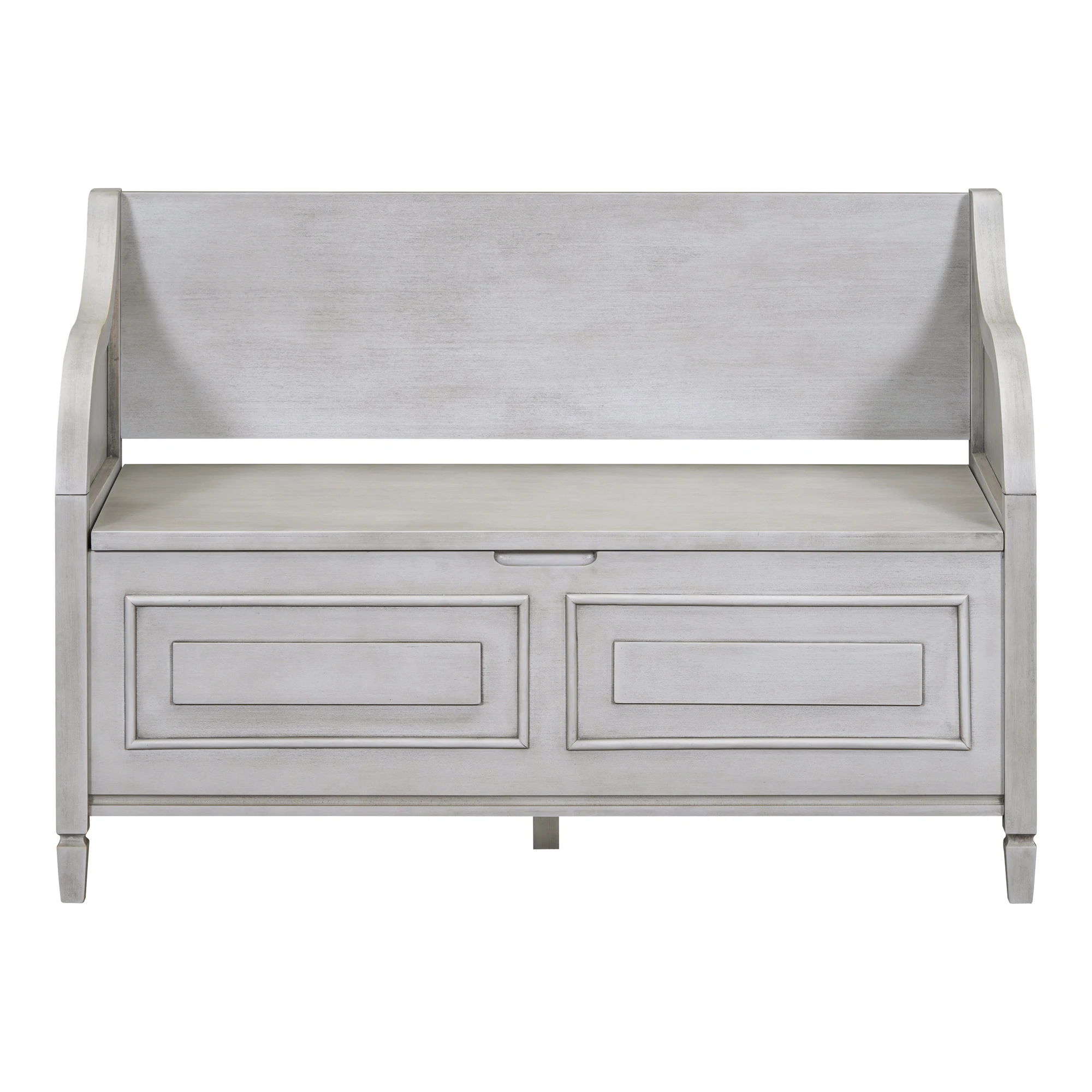
Material Considerations
The material of your storage bench significantly impacts both its durability and visual appeal:
- Solid wood offers classic appeal and outstanding durability, though at a higher price point
- Engineered wood provides good value with moderate durability at more accessible prices
- Metal frames with wood components combine strength with warmth
- Upholstered options add comfort and textile interest but require more maintenance in high-traffic areas
Size and Capacity Guidelines
When selecting a storage bench, consider these typical dimensions:
– Small benches: 24-36 inches wide (ideal for 1-2 people)
– Medium benches: 36-48 inches wide (accommodates 2-3 people)
– Large benches: 48-60+ inches wide (suitable for larger families)
Storage capacity varies similarly, with larger benches holding up to 8-10 pairs of adult shoes, while compact models might accommodate 3-4 pairs plus accessories.
Exploring entryway bench storage options reveals the wide range of configurations available to match your specific needs. The ideal height for comfortable seating typically ranges from 17-19 inches, which also happens to be ergonomically perfect for putting on shoes.
For those seeking a clean, uncluttered look, benches with hidden storage offer the perfect compromise between accessibility and visual simplicity. These designs maintain a sleek appearance while concealing the practical storage that keeps your entryway functioning smoothly.
When selecting a storage bench, remember to balance seating comfort with storage functionality—the most beautiful bench serves little purpose if it’s uncomfortable to sit on or doesn’t address your specific storage needs.
Hall Trees: Complete Entryway Organization Systems
When your entryway needs demand more than just seating and basic storage, hall trees offer a comprehensive solution that addresses virtually every organizational challenge. These multi-functional powerhouses combine a bench with vertical storage elements to create a complete entryway management system.
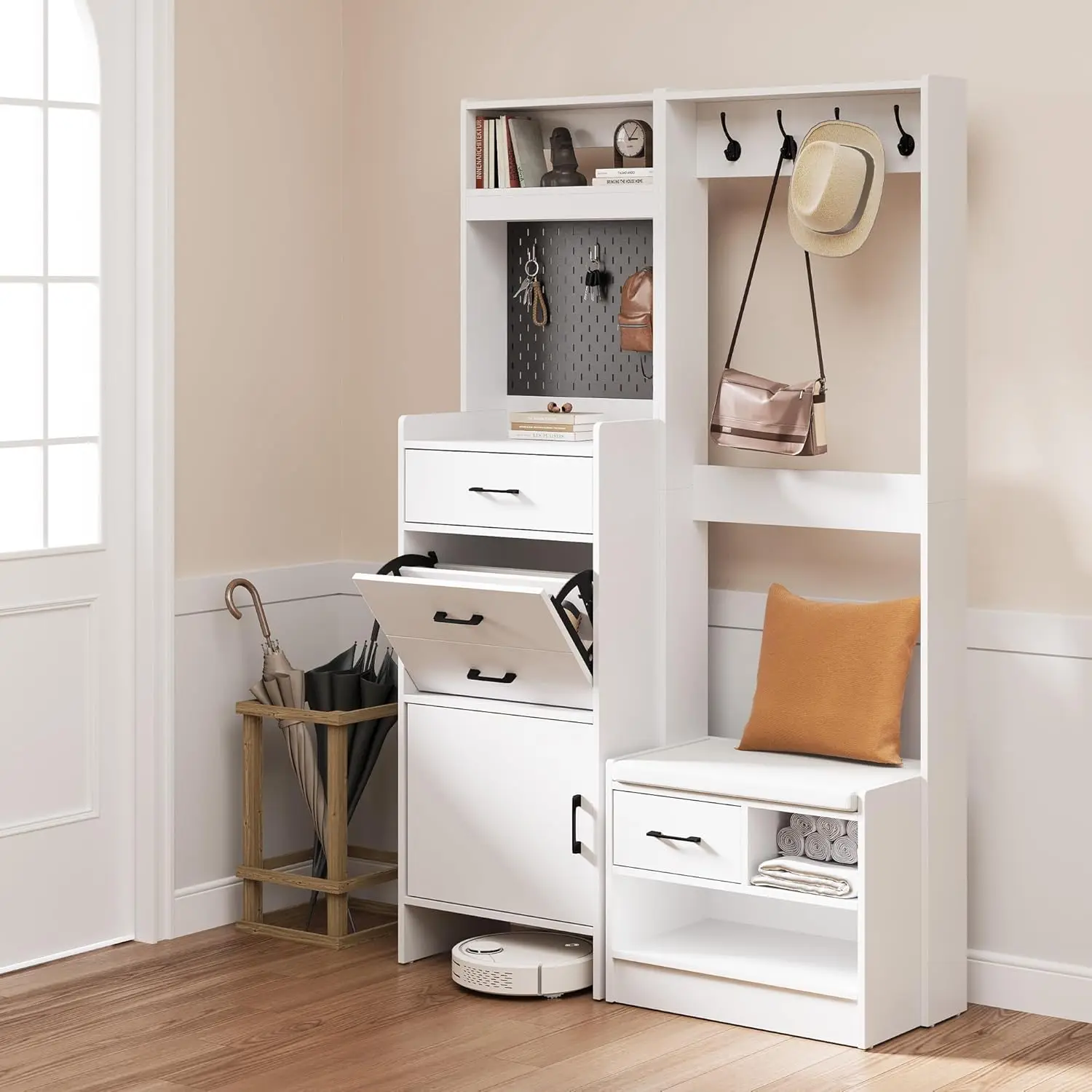
What Makes a Hall Tree Unique
A hall tree typically includes:
– A bench base for seating
– Coat hooks or a hanging rod for outerwear
– Upper shelving for hats, bags, or decorative items
– Often, lower storage (cubbies, cabinets, or drawers) for shoes and accessories
This vertical integration makes hall trees particularly valuable for maximizing storage capacity in limited floor space. By building upward, these pieces utilize wall space that would otherwise remain unused.
Space Requirements and Placement
Hall trees require more dedicated space than simple storage benches:
– Width: Typically 36-48 inches
– Depth: Usually 16-24 inches
– Height: Generally 60-78 inches
Due to their size, hall trees work best positioned against a wall with adequate ceiling clearance. They create a dedicated “drop zone” that contains and organizes all entryway essentials in one defined area, preventing clutter from spreading throughout adjacent spaces.
Organizational Capacity
The true advantage of hall trees lies in their comprehensive organization potential:
– Hook capacity: Most models offer 4-8 hooks for coats, bags, and accessories
– Shelf space: Upper shelves typically provide 3-6 cubic feet of storage
– Bench storage: Similar to storage benches, with capacity for 4-8 pairs of shoes
– Weight capacity: Quality hall trees support 250-400 pounds of seated weight, plus hanging items
Style Variations
Hall trees range from rustic farmhouse styles with distressed wood finishes to sleek contemporary designs with metal accents and clean lines. Traditional hall trees often feature crown molding and decorative details, while modern versions embrace minimalism with streamlined profiles.
Exploring various hall trees and coat rack benches reveals how manufacturers have adapted these versatile pieces to complement different home styles. For homes with traditional architecture, hall trees with detailed woodwork create a cohesive look, while minimalist designs better suit contemporary spaces.
The combination of entryway benches with coat rack solutions offers particularly valuable functionality during harsh weather seasons when outerwear management becomes more challenging. Having a dedicated place for wet coats and muddy boots prevents moisture and dirt from migrating throughout your home.
Hall trees represent an investment in organization that pays dividends in daily convenience. Their all-in-one nature eliminates the need to purchase separate pieces while creating a cohesive entryway statement that both welcomes guests and serves family needs.
Wall-Mounted Seating: Space-Saving Solutions for Narrow Entryways
When floor space comes at a premium, wall-mounted seating offers an elegant solution that maintains functionality without sacrificing precious square footage. These floating designs create seating and storage while maintaining an open, airy feel in tight entryways.
Space-Saving Benefits
Wall-mounted (or floating) benches free up floor space in several key ways:
– Eliminating legs creates an unobstructed floor area beneath the bench
– Visual lightness makes narrow passages feel less crowded
– The open space underneath improves traffic flow in high-use areas
– Floor cleaning becomes significantly easier with fewer obstacles
In the narrowest entryways, even saving 4-6 inches of floor projection compared to standard benches can make a meaningful difference in how the space functions.
Installation Considerations
Wall-mounted seating requires proper installation to ensure safety and stability:
– Secure attachment to wall studs is essential (not just drywall anchors)
– Weight capacity depends on proper mounting and wall structure
– Professional installation may be recommended for heavier units
– Load ratings typically range from 250-400 pounds when properly installed
Complementary Components
The true versatility of wall-mounted seating emerges when combined with other wall-mounted elements:
– Floating shelves above provide display and storage space
– Wall hooks create a complete organization system
– Mirrors expand visual space while serving a practical purpose
– Small floating cabinets add enclosed storage without floor footprint
These modular combinations allow you to create custom solutions that precisely fit your available wall space.
For extremely limited entryways, narrow entryway bench options provide specialized dimensions designed to work in constrained spaces. These slimmer profiles maintain functionality while respecting spatial limitations.
The best wall-mounted solutions emphasize clean lines and minimal visual weight, creating an impression of spaciousness even in tight quarters. For apartments, townhomes, or any home with limited entry space, these designs prevent the entryway from feeling cramped while still providing essential seating and organization.
Homeowners with small foyers can particularly benefit from multi-use furniture solutions that maximize functionality without overwhelming limited square footage. The key is selecting pieces scaled appropriately for your specific space constraints while prioritizing the functions you use most.
Modular and Customizable Entryway Solutions
The beauty of modular entryway furniture lies in its adaptability to your specific space and evolving needs. Unlike one-piece solutions, modular systems allow you to start with core components and expand or reconfigure as requirements change.
Understanding Modular Entryway Systems
Modular systems typically include mix-and-match components such as:
– Bench modules in various widths
– Storage cubes that can stand alone or combine with benches
– Wall panels with interchangeable hooks, shelves, and accessories
– Stackable components for vertical storage
– Connecting hardware that allows secure combination of pieces
This flexibility enables you to create configurations that precisely fit your available space rather than forcing a standard piece into a non-standard area.
Planning Your Modular Solution
When designing a modular entryway system, consider:
1. Measuring your space dimensions carefully, including height, width, and depth
2. Identifying your primary organizational needs (coats, shoes, bags, etc.)
3. Determining traffic patterns and how people move through the space
4. Planning for future expansion possibilities
5. Selecting a consistent style that works with various configurations
The most successful modular systems grow with your needs while maintaining visual cohesion throughout changes.
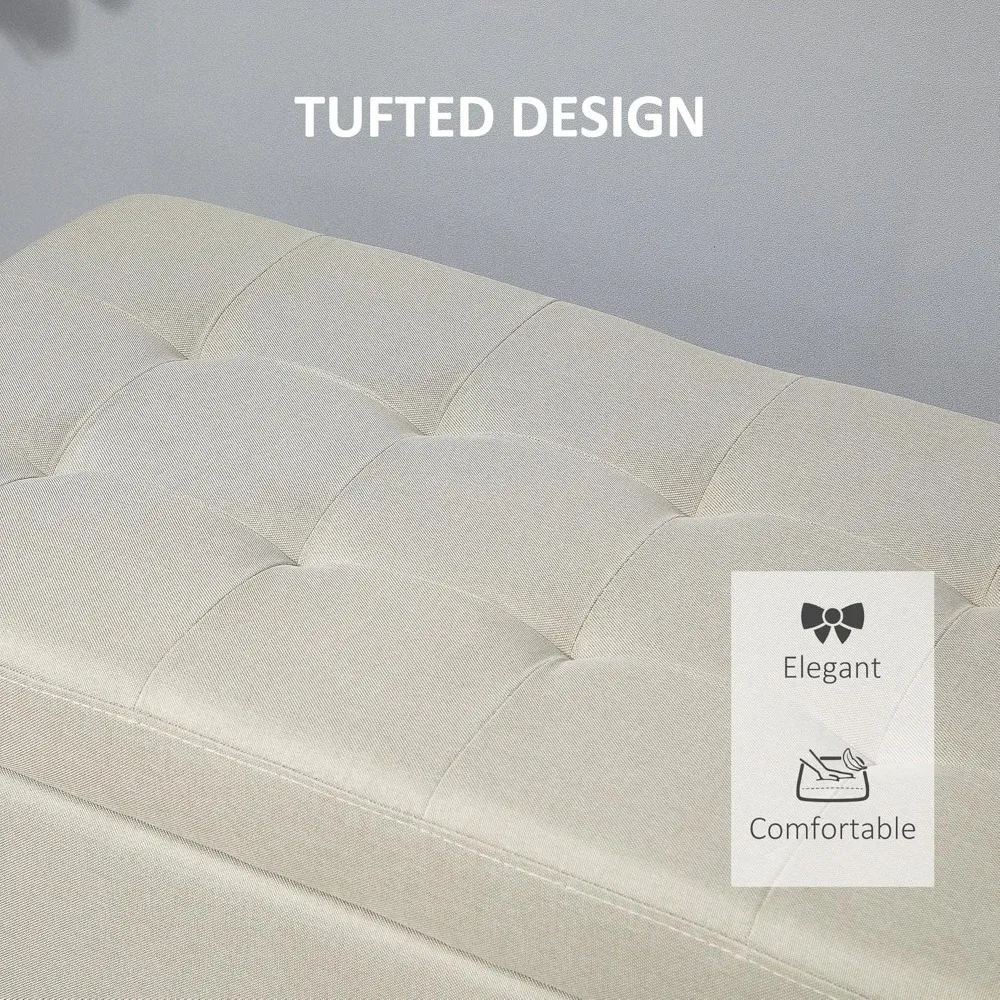
Expandability Benefits
The ability to expand your entryway solution provides significant advantages:
– Start with essential components and add more as budget allows
– Adjust to changing family needs (children growing up, new hobbies)
– Reconfigure seasonally for different storage requirements
– Take components with you when moving to different homes
– Replace individual pieces rather than entire sets if damage occurs
For growing families, this adaptability is particularly valuable as storage needs typically increase over time.
Exploring entryway benches with shelf storage reveals how these versatile components can be combined in various ways to create semi-custom solutions. The open shelf design allows for both storage and display, adding visual interest while maintaining functionality.
The modular approach also enables you to invest in quality pieces over time rather than purchasing an entire set at once. This gradual acquisition strategy often results in better-quality furniture that serves your needs more precisely than compromising on a less expensive all-in-one solution.
Specialized Multi-Functional Pieces for Unique Entryways
Not all entryways conform to standard rectangular layouts, which is why specialized multi-functional furniture has emerged to address challenging spaces. These innovative designs transform awkward areas into functional, organized entryways.
Corner Benches: Making Use of Neglected Spaces
Corner entryway benches transform often-wasted corner spaces into useful seating and storage:
– L-shaped designs maximize seating along two walls
– Triangular configurations fit snugly into corners
– Built-in storage utilizes the deeper space behind the corner
– Some models incorporate diagonal shoe storage for efficient use of corner depth
These specialized pieces can increase usable storage by 20-30% compared to standard benches in corner placements. Exploring corner entryway bench options reveals numerous designs specifically engineered for these challenging spaces.
Slim Console Tables with Seating
For extremely narrow entryways, console table and seating combinations offer elegant solutions:
– Slim console tables (10-12 inches deep) provide surface space without protruding far into walkways
– Bench seats tuck completely underneath when not in use
– Drawers or shelves in the console provide essential storage
– The arrangement separates into individual pieces when needed
This approach works particularly well in hallway-style entryways where depth is severely limited but length allows for a longer, narrower solution.
Hidden and Convertible Solutions
For formal entryways or multi-purpose spaces, discreet storage solutions maintain elegance:
– Ottomans with hidden storage compartments serve as seating when needed
– Flip-top designs transform from tables to seating with storage inside
– Nesting furniture pieces separate for parties and combine for daily use
– Pieces with wheels allow for quick reconfiguration as needs change
These versatile options are particularly valuable for homes where the entryway serves multiple purposes or opens directly into living areas.
For challenging spaces like split-level entryways, specialized designs incorporate features like:
– Adjustable-height components that work on different levels
– Stepped configurations that follow stair profiles
– Modular pieces that can be arranged to fit unusual architectural features
Space-saving corner bench solutions offer particularly creative approaches to utilizing awkward angles and maximizing every inch of available space. The best designs turn these challenging corners into attractive focal points rather than problem areas.
For homes with unique layouts, these specialized pieces often solve problems that standard furniture simply cannot address, making them worth the investment for their tailored functionality.
Material Selection and Durability Factors
The entryway endures some of the toughest conditions in your home—from wet boots and drippy umbrellas to the constant friction of daily use. Selecting appropriate materials ensures your multi-functional seating withstands these challenges for years to come.
Wood Options and Considerations
Wood remains one of the most popular materials for entryway furniture, offering warmth and durability:
Solid Wood Benefits:
– Exceptional durability with proper care
– Can be refinished if damaged
– Develops character with age
– Higher weight capacity than engineered alternatives
Engineered Wood Considerations:
– More affordable than solid wood
– Less susceptible to warping or cracking
– Often features wood veneer over particleboard or MDF
– Varies significantly in quality and durability
For traditional or transitional homes, wood entryway bench options complement architectural details while providing lasting functionality. Hardwoods like oak, maple, and walnut offer superior durability for high-traffic areas.
Metal Components and Framework
Metal elements add structural integrity and contemporary style:
– Steel frames provide excellent weight support (often 400+ pounds)
– Powder-coated finishes resist scratches and corrosion
– Industrial or modern aesthetic complements contemporary interiors
– Hybrid designs with wood seats offer warmth with metal durability
The sleek lines of metal frameworks work particularly well in minimalist or industrial-inspired spaces.
Upholstery Considerations
For comfort and style, upholstered elements require special consideration in entryway applications:
Recommended Fabrics:
– Performance fabrics with stain resistance
– Washable covers for bench cushions
– Outdoor-grade fabrics for entryways exposed to elements
– Leather or vinyl for easy cleaning
Durability Factors:
– Fabric weight (higher ounces per yard indicate better durability)
– Double rubs rating (20,000+ for residential use)
– Moisture and stain resistance treatments
– Removable/replaceable components
For entryways in wet climates, water-resistant materials like marine-grade vinyl or treated canvas offer practical benefits without sacrificing comfort.
Climate Considerations
Your local climate should influence material selection:
– High-humidity areas benefit from synthetic materials or moisture-resistant woods
– Dry climates may require woods with resistance to cracking
– Homes with extreme temperature fluctuations need materials that accommodate expansion/contraction
– Entryways exposed to direct sunlight need UV-resistant finishes to prevent fading
With proper material selection, your entryway furniture can maintain its appearance and functionality despite challenging conditions, providing lasting value and consistent performance.
Styling Your Multi-Functional Entryway Seating
Creating an entryway that’s both practical and visually appealing requires thoughtful styling. The right decorative elements transform functional furniture into an inviting first impression of your home.
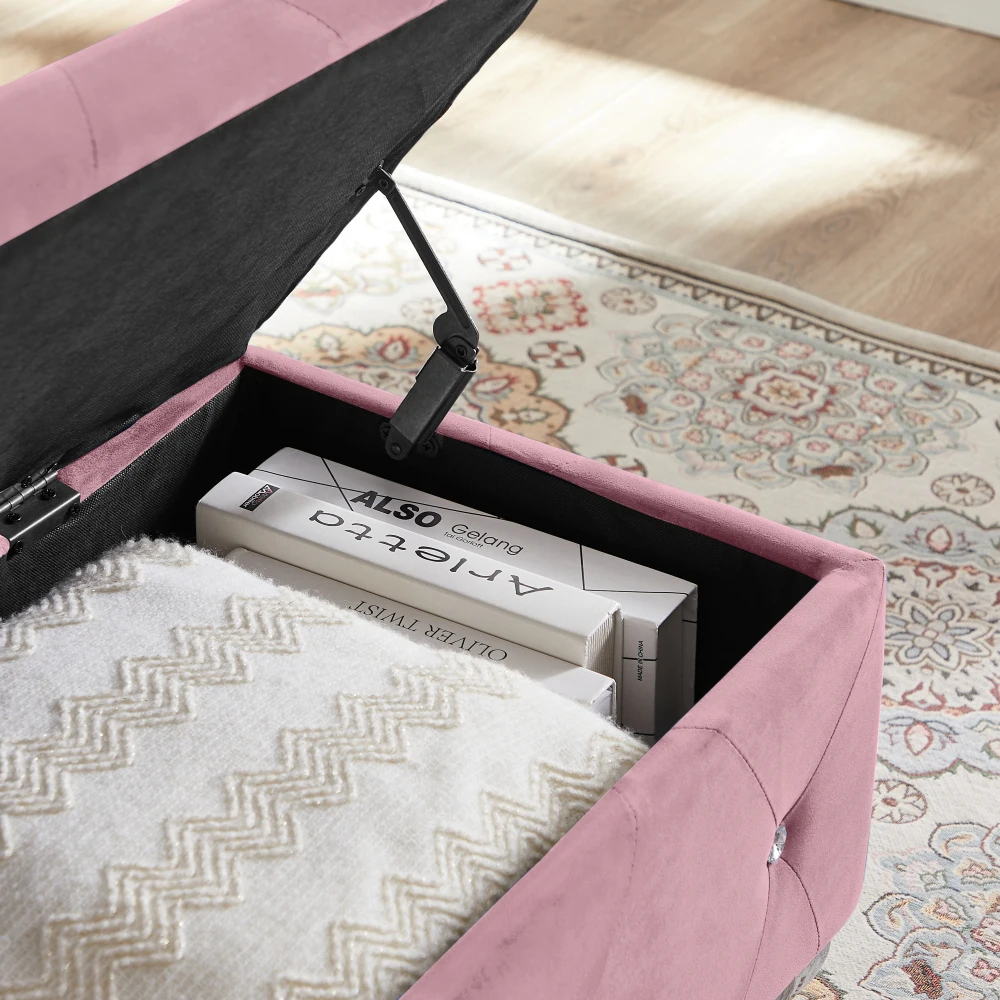
Coordinating with Your Home’s Aesthetic
Your entryway should create a coherent transition that reflects your home’s overall style:
For Modern Interiors:
– Clean lines and minimal ornamentation
– Neutral colors with strategic accent pieces
– Matte black hardware or brushed metal finishes
– Geometric patterns or texture for visual interest
For Traditional Spaces:
– Warm wood tones with classic detailing
– Symmetrical arrangements for balance
– Traditional patterns like stripes or subtle florals
– Antique or vintage-inspired accessories
For Farmhouse or Rustic Homes:
– Distressed or reclaimed wood elements
– Woven baskets for texture and storage
– Galvanized metal accents
– Natural fibers and materials
Color Strategy for Entryway Furniture
Color choices significantly impact how your entryway feels:
– Neutral furniture provides versatility with changing seasons and styles
– Bold color statements create memorable first impressions
– Cooler tones (blues, greens, grays) create calm, expansive feelings
– Warmer tones (reds, yellows, oranges) generate energy and warmth
For smaller spaces, lighter colors help create an airier feeling, while darker pieces can anchor larger entryways with dramatic presence.
Accessorizing Your Entryway Seating
The right accessories enhance both function and style:
– Cushions add comfort while introducing color and pattern
– Baskets bring texture while containing smaller items
– Decorative trays corral keys and everyday essentials
– Mirrors expand visual space while serving practical purposes
– Artwork or photographs personalize the space
Entryway bench cushion options can transform a simple bench into a comfortable, inviting spot while adding color and softness to balance harder architectural elements.
Seasonal Styling Adjustments
Refreshing your entryway seasonally creates year-round appeal:
– Summer: Lightweight baskets, bright cushions, and botanical elements
– Fall: Warmer textiles, deeper colors, and natural materials
– Winter: Additional lighting, cozy textures, and practical boot storage
– Spring: Fresh colors, lighter fabrics, and plant life
These seasonal adjustments keep your entryway feeling current while addressing changing storage and organizational needs throughout the year.
Lighting Considerations
Proper lighting elevates both the function and appearance of your entryway:
– Task lighting illuminates practical areas for finding keys or putting on shoes
– Ambient lighting creates a welcoming atmosphere
– Statement lighting fixtures express personal style
– Motion-sensor options provide hands-free convenience
A well-lit entryway not only looks more inviting but functions better during dark mornings or evenings.
Entryway Bench with Cushion, Mudroom Bench with Cushion, Shoe Bench for Entryway
$1,186.63 Select options This product has multiple variants. The options may be chosen on the product pageCoat Rack Shoe Bench, Corner Entryway Bench, Corner Hall Tree, Shoe Bench for Entryway
$313.58 Select options This product has multiple variants. The options may be chosen on the product pageEntryway Bench with Back, Modern Entryway Bench, Shoe Bench for Entryway
Price range: $463.13 through $474.44 Select options This product has multiple variants. The options may be chosen on the product pageEntryway Bench with Shelf Storage, Shoe Bench for Entryway, Shoe Storage Bench
$194.08 Select options This product has multiple variants. The options may be chosen on the product pageCorner Entryway Bench, Entryway Bench with Cushion, Modern Entryway Bench, Shoe Bench for Entryway
$476.34 Select options This product has multiple variants. The options may be chosen on the product pageBench with Hooks and Storage, Entryway Hall Tree, Mudroom Bench with Cubbies, Mudroom Bench with Shoe Storage
$818.38 Select options This product has multiple variants. The options may be chosen on the product page
Smart Organization Strategies for Entryway Seating Units
Even the most beautifully designed multi-functional seating will fall short of expectations without thoughtful organization strategies. Implementing smart systems ensures your entryway furniture maintains its functionality long-term.
Maximize Internal Storage Efficiency
Transform the interior of storage benches and compartments with these approaches:
– Use adjustable dividers to create customized sections
– Implement stackable containers to utilize vertical space
– Add fabric bins in coordinating colors for visual cohesion
– Install small hooks inside larger compartments for hanging items
These simple additions can increase usable storage capacity by 30-40% within the same physical space.
Create Personalized Zones
Family entryways function more smoothly with designated areas:
– Assign specific cubbies or compartments to each family member
– Use color-coding or labels for children’s items
– Position children’s storage at accessible heights
– Keep frequently used items in prime “real estate” locations
This personalization reduces morning chaos and helps maintain organization naturally.
Implement Seasonal Rotation Systems
Not all entryway items need to be accessible year-round:
– Store off-season gear in less accessible areas or elsewhere
– Maintain a quarterly rotation schedule for seasonal switches
– Use vacuum bags to compress bulky winter items during summer months
– Keep a small “transition bin” for unpredictable weather periods
This systematic rotation prevents overcrowding while ensuring essentials remain accessible.
Daily Maintenance Routines
Simple daily habits prevent entryway disorganization:
– Implement a “one in, one out” policy for coats and shoes
– Create a five-minute end-of-day reset routine
– Position a small basket for items that need to be relocated
– Establish a designated spot for items leaving the house tomorrow
These small habits prevent the gradual accumulation that leads to major clutter.
Smart entryway storage seating solutions combine thoughtful furniture design with practical organization systems, creating entryways that stay functional despite daily use. The most successful approaches adapt to your specific family needs while remaining simple enough to maintain consistently.
For families with children, consider including lower storage areas that kids can access independently, encouraging them to develop organization habits from an early age. This approach not only maintains a neater entryway but builds valuable life skills.
How to Choose the Perfect Multi-Functional Entryway Seating
Selecting the ideal multi-functional entryway seating requires thoughtful consideration of your specific needs, space constraints, and design preferences. This systematic approach helps ensure you make the right investment.
Space Assessment and Measurement
Begin with precise measurements of your available space:
– Width: Measure the wall space where the furniture will be placed
– Depth: Determine how far the piece can extend without impeding traffic flow (typically 14-24 inches)
– Height: Consider ceiling height for tall pieces and comfortable seating height (17-19 inches)
– Clearance: Allow at least 36 inches of walkway space in front of the furniture
Remember to account for door swings, heating vents, electrical outlets, and any architectural features that might affect placement.
Needs Analysis
Create a prioritized list of your specific needs:
1. Primary storage requirements (shoes, coats, bags, etc.)
2. Number of family members using the space
3. Seasonal considerations for your climate
4. Special items requiring storage (sports equipment, pet supplies)
5. Additional functions beyond storage and seating
This assessment helps you focus on solutions that address your most important challenges rather than being swayed by aesthetics alone.
Quality Indicators
Look for these signs of quality construction:
– Solid wood components in structural areas
– Reinforced joints (dowels, screws, and glue rather than just staples)
– Smooth-operating hinges and drawer glides
– Even finish application without drips or inconsistencies
– Weight appropriate to materials (heavier typically indicates more solid construction)
– Warranty coverage that reflects manufacturer confidence
Investment in quality construction typically results in furniture that remains functional for 10+ years rather than requiring replacement after 2-3 years.
When researching options, exploring practical entryway furniture ideas can help you identify designs that balance aesthetics with genuine utility. The most successful pieces combine beauty with thoughtful features that address real-world entryway challenges.
For assembly considerations, factor in your comfort level with DIY projects. Some pieces require significant assembly time and basic tools, while others arrive nearly ready to use. This practical factor can impact both initial satisfaction and long-term durability.
Budget-Friendly Multi-Functional Entryway Ideas
Creating an organized, multi-functional entryway doesn’t necessarily require a large investment. With creative approaches and strategic purchasing, you can achieve impressive results across various budget levels.
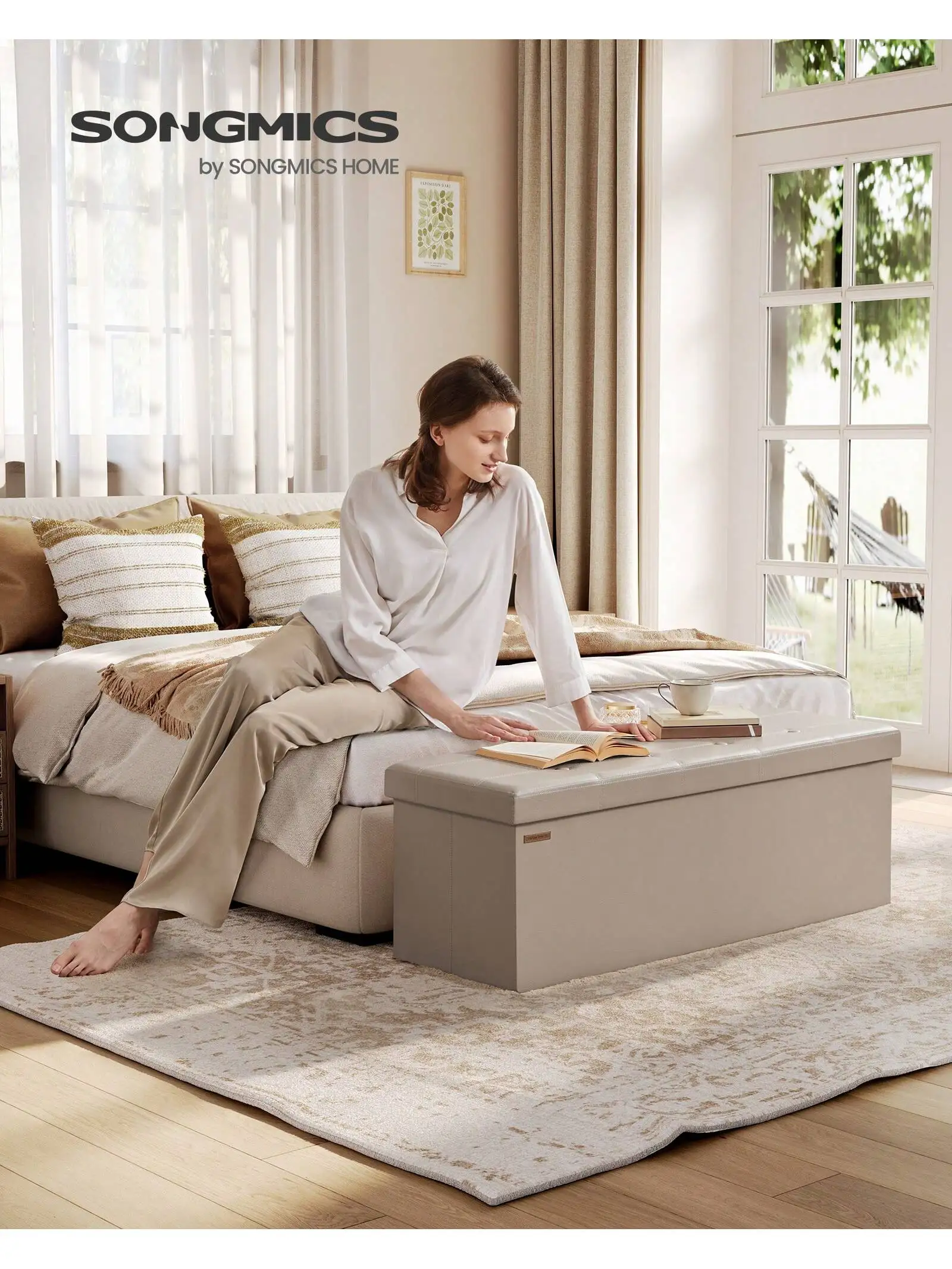
DIY Entryway Solutions
For those with basic tools and some woodworking skills, DIY projects offer customization at lower cost:
– Simple storage bench construction using plywood and basic lumber
– Wall-mounted shoe storage with integrated seating
– Repurposed kitchen cabinets topped with cushions for bench seating
– Floating bench installations with storage baskets underneath
These projects typically cost 40-60% less than comparable retail options, with the added benefit of custom dimensions for your specific space.
Upcycling Existing Furniture
Transforming existing pieces creates unique entryway solutions:
– Convert a dresser to a bench by removing top drawers and adding a cushion
– Repurpose an old bookcase horizontally as a bench with storage cubbies
– Transform a coffee table with the addition of baskets underneath
– Add hooks and a shelf above a basic bench for expanded functionality
These creative approaches give new life to unused furniture while reducing environmental impact.
Affordable Retail Strategies
When purchasing new pieces, maximize value with these approaches:
– Look for floor models or open-box items at significant discounts
– Consider smaller-scale small entryway bench options which typically cost less
– Watch for seasonal sales, particularly in January and July
– Focus on unfinished furniture you can customize with paint or stain
– Start with core pieces and add accessories over time
Many retailers offer budget lines with simpler designs but similar functionality to their premium collections.
Mix and Match Approach
Creating a cohesive look without buying matching sets:
– Choose a consistent wood tone or color palette across different pieces
– Use coordinating hardware to unify disparate items
– Add matching cushions or accessories to create visual connections
– Paint separate pieces the same color for a custom look
This approach allows you to acquire quality pieces gradually as budget allows, rather than compromising on a complete but lower-quality set.
For the most budget-conscious consumers, starting with a simple bench and adding organizational elements gradually creates immediate seating while building toward a complete solution over time. This phased approach allows for investment in better-quality core pieces that will last for years.
Maximizing Small Entryways: Tips for Tight Spaces
Small entryways present unique challenges but can become remarkably functional with the right approach. Strategic furniture selection and placement transforms even the tightest spaces into efficient, welcoming entries.
Scale-Appropriate Furniture Selection
In compact spaces, proper sizing becomes critical:
– Narrow benches (10-14 inches deep) maintain walkway space
– Wall-mounted pieces free up valuable floor area
– Height-proportional pieces prevent visual overwhelm
– Multi-functional items eliminate the need for multiple pieces
For extremely tight spaces, consider furniture designed specifically for small areas rather than trying to squeeze standard-sized pieces into limited space.
Visual Space-Enhancing Techniques
Create the illusion of more space with these design approaches:
– Light colors expand visual perceptions of size
– Mirrors strategically placed to reflect light and space
– Transparent or translucent materials reduce visual weight
– Furniture with visible legs creates a sense of openness underneath
– Consistent color palette minimizes visual fragmentation
These techniques can make even the smallest entry feel more spacious and welcoming.
Vertical Storage Maximization
When floor space is limited, building upward offers solutions:
– Wall-mounted hooks at varying heights utilize otherwise unused wall space
– Floating shelves above seating create display and storage opportunities
– Tall, narrow cabinets provide substantial storage with minimal footprint
– Over-door organizers add function without consuming space
By utilizing wall space from floor to ceiling, you can triple the storage capacity without expanding horizontal footprint.
Corner and Awkward Space Utilization
Challenging architectural features can become opportunities:
– Corner benches transform awkward angles into functional seating
– Customizable modular pieces conform to unusual dimensions
– Triangular or wedge-shaped furniture fits where rectangular pieces cannot
– Built-in or semi-custom solutions maximize every available inch
These specialized approaches often extract remarkable functionality from previously unused spaces.
For homes with hallway-style entrances, functional hallway seating solutions offer specialized designs that provide essential functionality without obstructing traffic flow. These streamlined options prioritize slim profiles while maintaining practical storage and seating features.
In the smallest spaces, prioritize your absolute essentials and design around those needs first. Even a tiny entry can accommodate a place to sit, storage for a few pairs of shoes, and hooks for coats when furniture is selected specifically for these spatial constraints.
Frequently Asked Questions About Multi-Functional Entryway Seating
What is the ideal height for comfortable entryway seating?
The optimal height for entryway benches is 17-19 inches from the floor to the seating surface. This range accommodates most adults comfortably while providing appropriate ergonomics for putting on and removing shoes. For households with elderly members, slightly higher seating (19-21 inches) may provide easier transitions from sitting to standing.
How much weight can entryway furniture typically support?
Weight capacity varies significantly based on construction:
– Standard storage benches: 250-350 pounds of seated weight
– Heavy-duty wooden benches: 400-500 pounds
– Metal-frame benches: 300-600 pounds depending on gauge
– Wall-mounted options: 200-300 pounds when properly installed
Always check manufacturer specifications, as exceeding weight capacity can compromise both safety and furniture longevity.
What installation requirements should I consider?
Installation considerations vary by furniture type:
– Freestanding pieces require no installation but should be placed on level surfaces
– Wall-mounted items need secure attachment to wall studs, not just drywall
– Large hall trees may require anti-tip hardware for safety
– Some modular systems require connecting hardware between pieces
For wall-mounted furniture, professional installation is recommended if you’re uncertain about locating studs or proper mounting techniques.
How do I clean and maintain different entryway furniture materials?
Maintenance requirements differ by material:
– Wood: Dust regularly and clean with appropriate wood cleaner; avoid excess moisture
– Upholstery: Vacuum regularly; treat stains immediately with appropriate cleaners
– Metal: Wipe with damp cloth; touch up any chips in finish to prevent rust
– Engineered wood: Clean with slightly damp cloth; avoid saturating the surface
For high-traffic entryways, quarterly deep cleaning and annual maintenance checks help extend furniture life significantly.
Can I customize standard entryway furniture for unique spaces?
Many standard pieces can be adapted for custom applications:
– Storage benches can often be shortened by a skilled woodworker
– Some modular systems can be configured for unusual dimensions
– DIY modifications like adding cushions or changing hardware personalize standard pieces
– Custom paint or refinishing transforms appearance without altering functionality
For truly unique spaces, semi-custom furniture from smaller manufacturers often offers sizing adjustments for a reasonable upcharge.
How long should quality entryway furniture last?
With proper care, you can expect:
– Solid wood pieces: 15-20+ years
– Quality engineered wood: 7-12 years
– Metal-frame furniture: 10-15+ years
– Upholstered elements: 5-8 years before potential reupholstering needs
Investing in higher-quality construction typically yields furniture that remains functional two to three times longer than budget alternatives.
Transform Your Home’s First Impression: Our Top Picks for Multi-Functional Entryway Seating
The entryway sets the tone for your entire home, making the selection of multi-functional seating an important decision that impacts both daily convenience and overall impression. Nested Goods has curated exceptional options that combine premium materials, thoughtful design, and lasting quality.
When evaluating premium multi-functional entryway seating, certain features distinguish exceptional pieces from merely adequate ones:
Superior Construction Elements
The finest entryway furniture incorporates construction details that ensure longevity:
– Solid hardwood frames providing structural integrity
– Reinforced joinery techniques like mortise-and-tenon or dovetail connections
– Full-extension drawer glides rated for heavy daily use
– Soft-close hinges that prevent slamming and reduce wear
– Water-resistant finishes that protect against everyday spills and moisture
These quality construction methods translate directly into furniture that maintains its functionality and appearance despite years of daily use.
Innovative Storage Solutions
Premium pieces often incorporate thoughtful storage features:
– Divided compartments that organize items by type or family member
– Specialized storage for frequently forgotten items like keys and mail
– Ventilated shoe storage that allows air circulation
– Hidden compartments for valuables or rarely used items
– Modular components that adapt to changing storage needs
These intelligent design elements transform simple storage into comprehensive organization systems.
For homes requiring significant storage capacity in a sophisticated package, entryway benches with drawer storage offer elegant solutions that conceal contents while providing easy access. The smooth operation of quality drawer glides makes these pieces particularly user-friendly for daily use.
When selecting your entryway seating, consider how the piece will function within your specific home environment and daily routines. The most successful entryway furnishings aren’t simply beautiful—they’re hardworking organizational tools that simplify your life while enhancing your home’s aesthetic appeal.
With thoughtful selection of multi-functional entryway seating, you transform not just your physical space but your daily experience of coming home. The right piece welcomes you while effortlessly organizing the essentials that accompany your comings and goings, creating harmony where chaos once reigned.

